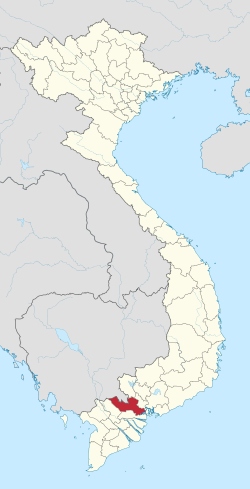Long An
|
Long An Province Tỉnh Long An |
|
|---|---|
| Province | |
 Location of Long An within Vietnam |
|
| Coordinates: 10°40′N 106°10′E / 10.667°N 106.167°ECoordinates: 10°40′N 106°10′E / 10.667°N 106.167°E | |
| Country |
|
| Region | Mekong Delta |
| Capital | Tân An |
| Government | |
| • People's Council Chair | Trương Văn Tiếp |
| • People's Committee Chair | Dương Quốc Xuân |
| Area | |
| • Total | 4,495.5 km2 (1,735.7 sq mi) |
| Population (2004) | |
| • Total | 1,477,300 |
| • Density | 330/km2 (850/sq mi) |
| Demographics | |
| • Ethnicities | Vietnamese, others |
| Time zone | ICT (UTC+7) |
| Calling code | 72 |
| ISO 3166 code | VN-41 |
| Website | eng |
Long An (![]() listen) is a province in the Mekong Delta region of southern Vietnam. The provincial capital is Tân An, and other major cities include Bến Lức, Đức Hòa and Mộc Hóa. There are 13 districts within the province.
listen) is a province in the Mekong Delta region of southern Vietnam. The provincial capital is Tân An, and other major cities include Bến Lức, Đức Hòa and Mộc Hóa. There are 13 districts within the province.
Long An is situated in an advantageous position in the Southern Key Economic Region of Vietnam. It serves as a bridge between Ho Chi Minh City in the north and 12 provinces in the Mekong Delta in the south. The province also has Cambodia to its west and the East Sea (South China Sea) to its east.
Long An is a low-lying coastal region, and therefore some areas of it are subject to flooding during the rainy season, which lasts from the beginning of August until November.
The province has numerous rivers. Two of the main ones are the Vàm Cỏ Đông and Vàm Cỏ Tay, which connect with the Tiền to form a larger river system. Another important river in the region is the Soài Rạp.
Long An is subdivided into 15 district-level sub-divisions:
They are further subdivided into 14 commune-level towns (or townlets), 166 communes, and 12 wards.
...
Wikipedia
